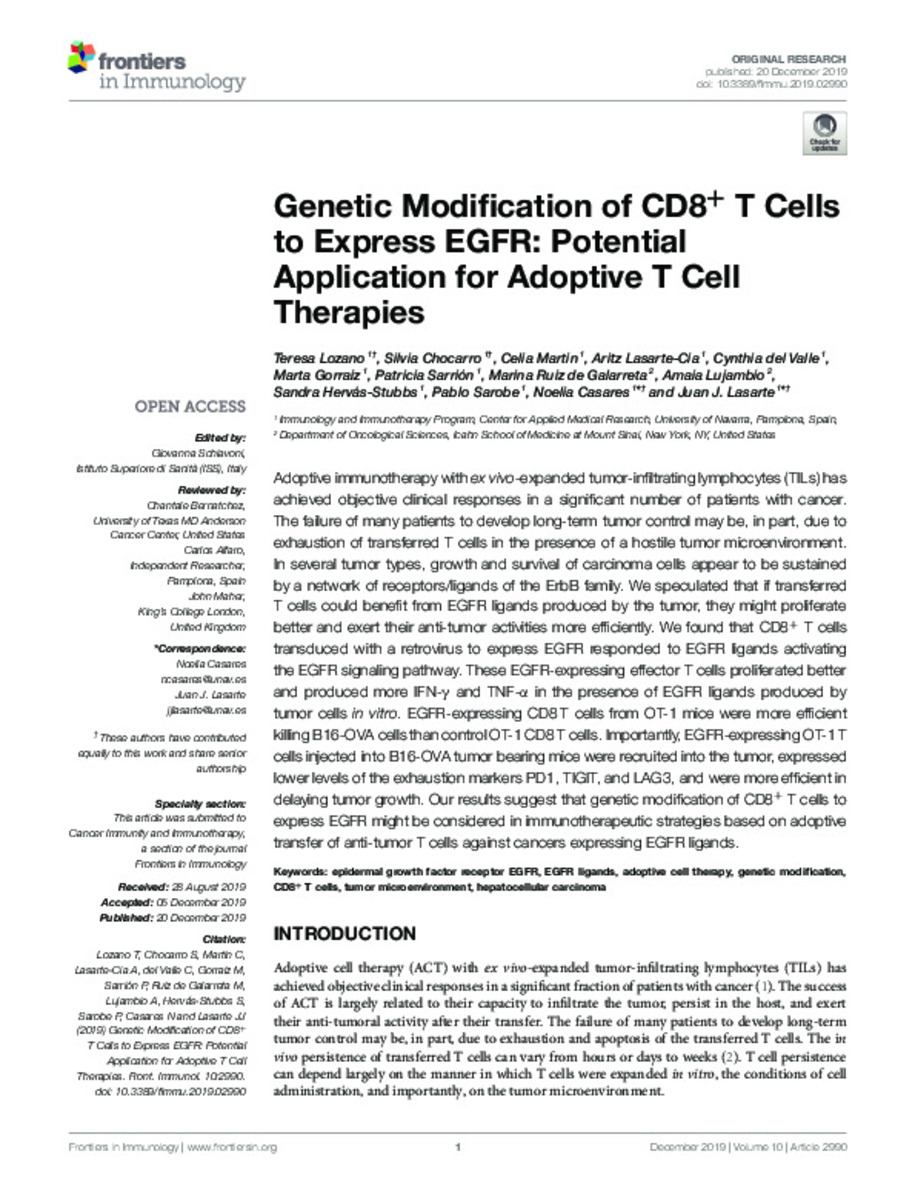Full metadata record
| DC Field | Value | Language |
|---|---|---|
| dc.creator | Lozano-Moreda, T. (Teresa) | - |
| dc.creator | Chocarro, S. (Silva) | - |
| dc.creator | Martin, C. (Celia) | - |
| dc.creator | Lasarte-Cia, A. (Aritz) | - |
| dc.creator | Valle, C. (Cynthia) del | - |
| dc.creator | Gorraiz, M. (Marta) | - |
| dc.creator | Sarrión, P. (Patricia) | - |
| dc.creator | Ruiz-de-Galarreta-Martínez, M. (Marina) | - |
| dc.creator | Lujambio, A. (Amaya) | - |
| dc.creator | Hervas-Stubbs, S. (Sandra) | - |
| dc.creator | Sarobe, P. (Pablo) | - |
| dc.creator | Casares, N. (Noelia) | - |
| dc.creator | Lasarte, J.J. (Juan José) | - |
| dc.date.accessioned | 2022-06-01T12:21:49Z | - |
| dc.date.available | 2022-06-01T12:21:49Z | - |
| dc.date.issued | 2019 | - |
| dc.identifier.citation | Lozano, T. (Teresa); Chocarro, S. (Silva); Martin, C. (Celia); et al. "Genetic modification of CD8+ T cells to express EGFR: Potential application for adoptive T cell therapies". . 10, 2019, 2990 | es |
| dc.identifier.issn | 1664-3224 | - |
| dc.identifier.uri | https://hdl.handle.net/10171/63595 | - |
| dc.description.abstract | Adoptive immunotherapy with ex vivo-expanded tumor-infiltrating lymphocytes (TILs) has achieved objective clinical responses in a significant number of patients with cancer. The failure of many patients to develop long-term tumor control may be, in part, due to exhaustion of transferred T cells in the presence of a hostile tumor microenvironment. In several tumor types, growth and survival of carcinoma cells appear to be sustained by a network of receptors/ligands of the ErbB family. We speculated that if transferred T cells could benefit from EGFR ligands produced by the tumor, they might proliferate better and exert their anti-tumor activities more efficiently. We found that CD8+ T cells transduced with a retrovirus to express EGFR responded to EGFR ligands activating the EGFR signaling pathway. These EGFR-expressing effector T cells proliferated better and produced more IFN-γ and TNF-α in the presence of EGFR ligands produced by tumor cells in vitro. EGFR-expressing CD8 T cells from OT-1 mice were more efficient killing B16-OVA cells than control OT-1 CD8 T cells. Importantly, EGFR-expressing OT-1 T cells injected into B16-OVA tumor bearing mice were recruited into the tumor, expressed lower levels of the exhaustion markers PD1, TIGIT, and LAG3, and were more efficient in delaying tumor growth. Our results suggest that genetic modification of CD8+ T cells to express EGFR might be considered in immunotherapeutic strategies based on adoptive transfer of anti-tumor T cells against cancers expressing EGFR ligands. | es_ES |
| dc.description.sponsorship | This study was supported by grants from Ministerio de Educación y Ciencia (SAF2016-78568-R, SAF2019-08971-R to JL), Fundación Ramón Areces, Gobierno de Navarra Industria (0011-1411-2019-000079; Proyecto DESCARTHeS), and Fundación Bancaria La Caixa-Hepacare Project. | es_ES |
| dc.language.iso | spa | es_ES |
| dc.publisher | Frontiers Media SA | es_ES |
| dc.rights | info:eu-repo/semantics/openAccess | es_ES |
| dc.subject | Epidermal growth factor receptor EGFR | es_ES |
| dc.subject | EGFR ligands | es_ES |
| dc.subject | Adoptive cell therapy | es_ES |
| dc.subject | Genetic modification | es_ES |
| dc.subject | CD8+ T cells | es_ES |
| dc.subject | Tumor microenvironment | es_ES |
| dc.subject | Hepatocellular carcinoma | es_ES |
| dc.title | Genetic modification of CD8+ T cells to express EGFR: Potential application for adoptive T cell therapies | es_ES |
| dc.type | info:eu-repo/semantics/article | es_ES |
| dc.description.note | This is an open-access article distributed under the terms of the Creative Commons Attribution License (CC BY). The use, distribution or reproduction in other forums is permitted, provided the original author(s) and the copyright owner(s) are credited and that the original publication in this journal is cited, in accordance with accepted academic practice. No use, distribution or reproduction is permitted which does not comply with these terms. | es_ES |
| dc.identifier.doi | 10.3389/fimmu.2019.02990 | - |
| dadun.citation.startingPage | 2990 | es_ES |
| dadun.citation.volume | 10 | es_ES |
Files in This Item:
Statistics and impact
Items in Dadun are protected by copyright, with all rights reserved, unless otherwise indicated.






